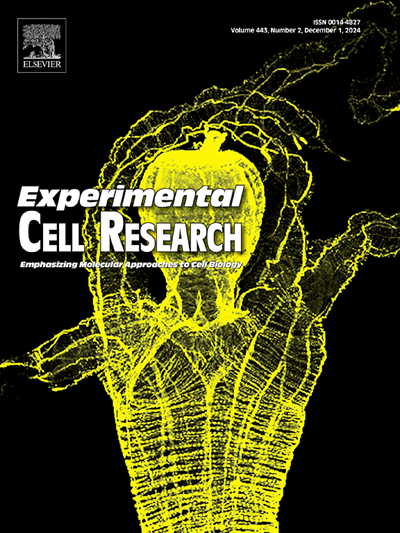Small RNA sequencing of differentiated astrocytoma exposed to NMOSD patient sera reveals perturbations in neurodegenerative signaling
IF 3.3
3区 生物学
Q3 CELL BIOLOGY
引用次数: 0
Abstract
The signaling pathways behind severe astrocytic lysis with Aquaporin4 auto-antibody (AQP4-IgG) seropositivity, and reactive astrocytosis with myelin oligodendrocyte glycoprotein auto-antibody (MOG-IgG) seropositivity, remain largely unexplored in Neuromyelitis optica spectrum disorder (NMOSD), while almost no molecular details being known about double-seronegative (DN) patients. Recent discovery of glial fibrillary acidic protein (GFAP) in DN NMOSD patients’ cerebrospinal fluid, akin to AQP4-IgG + ve cases, suggests astrocytopathy. Here, we aim to study small non coding RNA (sncRNA) signature alterations in astrocytes exposed to AQP4-IgG + ve and MOG-IgG + ve patient sera, and their potential resemblance with DN-NMOSD. Next Generation Sequencing (NGS) revealed differential expression of several microRNAs with notable alterations in hsa-miR-6824-3p, hsa-miR-324-5p and hsa-miR-4466 respectively upon sera treatment. Results with DN-NMOSD patient sera are majorly similar to that of AQP4+ve sera. Strikingly, in all three treatments, hsa-miR-200b-3p was significantly upregulated. Functional enrichment analysis revealed that Hippo and FoxO signaling pathways were primarily impacted in AQP4-IgG + ve and double negative sera treated cells whereas, MOG-IgG + ve sera treatment perturbed the PI3K-Akt and MAPK signaling pathways. Furthermore, NGS also revealed differential expression of several piRNAs in cells upon treatment with AQP4-IgG + ve and MOG-IgG + ve sera and VEGF signaling was identified as the common target of differentially expressed piRNAs of both the groups. This study, for the first time, revealed that the molecular pathophysiology of double-seronegative NMOSD might involve astrocytopathy akin to AQP4+ve NMOSD, thus pointing towards the possible existence of unidentified astrocytic autoimmune targets and identified the major alterations in intracellular sncRNAs and the associated overall cellular signaling pathways that potentially contribute to the fate of astrocytes during the progression of the disease.

暴露于NMOSD患者血清的分化星形细胞瘤的小RNA测序显示神经退行性信号的扰动。
在视神经脊髓炎谱系障碍(NMOSD)患者中,伴有Aquaporin4自身抗体(AQP4-IgG)阳性的严重星形细胞溶解和髓鞘少突胶质细胞糖蛋白自身抗体(MOG-IgG)阳性的反应性星形细胞溶解背后的信号通路在很大程度上仍未被探索,而双血清阴性(DN)患者的分子细节几乎没有被了解。最近在DN NMOSD患者脑脊液中发现胶质原纤维酸性蛋白(GFAP),与AQP4-IgG+ve相似,提示星形细胞病变。在这里,我们的目的是研究暴露于AQP4-IgG+ve和MOG-IgG+ve患者血清中的星形胶质细胞的小非编码RNA (sncRNA)特征改变,以及它们与DN-NMOSD的潜在相似性。下一代测序(NGS)揭示了几种microrna的差异表达,hsa-miR-6824-3p、hsa-miR-324-5p和hsa-miR-4466分别在血清处理后发生了显著变化。DN-NMOSD患者血清与AQP4+ve患者血清结果基本相似。引人注目的是,在所有三种治疗中,hsa-miR-200b-3p显著上调。功能富集分析显示,在AQP4-IgG+ve和双阴性血清处理的细胞中,Hippo和FoxO信号通路主要受到影响,而MOG-IgG+ve血清处理的细胞则干扰PI3K-Akt和MAPK信号通路。此外,NGS还发现,在AQP4-IgG+ve和MOG-IgG+ve血清处理后,细胞中几种pirna的表达存在差异,VEGF信号被确定为两组差异表达pirna的共同靶点。本研究首次揭示了双血清阴性NMOSD的分子病理生理可能涉及类似AQP4+ve NMOSD的星形细胞病变,从而指出可能存在未知的星形细胞自身免疫靶点,并确定了细胞内sncrna的主要改变和相关的整体细胞信号通路,这些通路可能在疾病进展过程中影响星形细胞的命运。
本文章由计算机程序翻译,如有差异,请以英文原文为准。
求助全文
约1分钟内获得全文
求助全文
来源期刊

Experimental cell research
医学-细胞生物学
CiteScore
7.20
自引率
0.00%
发文量
295
审稿时长
30 days
期刊介绍:
Our scope includes but is not limited to areas such as: Chromosome biology; Chromatin and epigenetics; DNA repair; Gene regulation; Nuclear import-export; RNA processing; Non-coding RNAs; Organelle biology; The cytoskeleton; Intracellular trafficking; Cell-cell and cell-matrix interactions; Cell motility and migration; Cell proliferation; Cellular differentiation; Signal transduction; Programmed cell death.
 求助内容:
求助内容: 应助结果提醒方式:
应助结果提醒方式:


